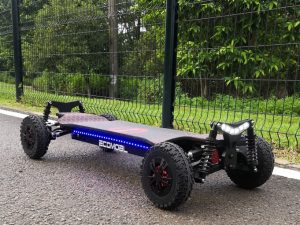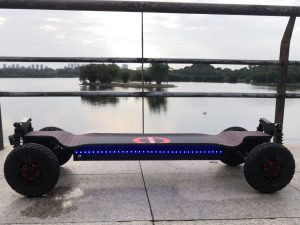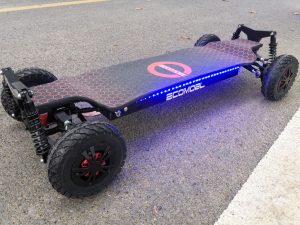Electric skateboards, also known as e-skateboards, have soared in popularity recently. These battery-powered boards allow you to zip and glide effortlessly thanks to an electric motor that provides momentum. Suppose you’ve seen riders gracefully coasting around on e-skateboards and thought it looked fun.
In that case, you may wonder if you need any prior skating or riding experience before purchasing one. While some familiarity with board sports can help, complete beginners can learn to ride electric skateboards safely with some practice. In this beginner’s guide, we’ll cover the basics of e-skateboards, choosing the right one, and tips for learning to ride safely as a novice.

What Are Electric Skateboards?
Electric skateboards emerged in the early 2000s as companies began experimenting with motorizing traditional skateboards using battery power. However, the technology was still fairly primitive. Today, there is an extensive range of e-skateboard brands and models.
At its core, an electric skateboard uses a rechargeable battery (usually lithium-ion) to power a small electric motor. This motor drives the wheels through a belt drive system or hub motors inside the wheels. The rider uses a handheld throttle, often called a remote, to control the motor and speed. Many e-skateboards can reach upwards of 20mph, with high-performance models exceeding 30mph. This makes them an efficient, eco-friendly mode of urban transportation in addition to a fun recreational activity.
Do You Need Riding Experience to Use an E-Skateboard?
The great thing about electric skateboards is that no prior experience is required before you buy and start riding one. Some general board sports experience can help you pick up e-skateboarding more quickly. Those skills will translate well if you’re comfortable balancing and maneuvering on skateboards, surfboards, or snowboards. But even as a total beginner, you can learn to ride an e-skateboard safely.
E-skateboards have a learning curve, especially regarding throttle control, braking, and balancing at faster speeds. Take things slowly, use proper safety gear, and practice in areas away from vehicles and crowds. The power assist provided by the electric motor helps stabilize the board and makes accelerating easier compared to pushing a manual skateboard. While experienced skaters may advance faster, e-skateboarding is an intuitive activity that most people can grasp with enough practice. Be patient with yourself, and don’t get discouraged. The payoff in cruising freedom is well worth the initial learning phase.

Choosing Your First E-Skateboard
As a beginner, you’ll want an e-skateboard that is easy to control but still fun to ride. Here are some key features to look for in your starter electric skateboard:
- Top Speed – Look for a max of 15-20mph. Faster than that can be hard to handle for beginners.
- Range – 7-10 miles per charge is ideal. Enough for urban commuting or leisure riding.
- Weight – Lighter boards around 10lbs are easier to carry and maneuver.
- Deck style – A standard popsicle skateboard deck offers stability. Longboards can be trickier.
- Wheel size – Larger 75-85mm wheels absorb bumps better but reduce torque. Smaller wheels pick up speed quickly.
- Price – Budget $300-$800 for a quality beginner model. High-performance boards run $1,000-plus.
Stick to reputable, well-reviewed brands. Cheaper boards often have quality issues and won’t be as safe or enjoyable to learn. Investing in a solid e-skateboard suited for beginners will make learning much smoother.
Learning to Ride an E-Skateboard
Once you have your protective gear on and have found a large open space for practice, it’s time to start riding your e-skateboard. Here are some step-by-step tips for beginners:
- Place one foot on the board while pushing off gently with the other. Find your balance before starting the motor.
- Position your front foot over the front truck in the center of the board to steer. Put your back foot in the concave section perpendicular to the deck.
- Lean forward slowly to start the motor and accelerate. Come back to neutral to maintain speed.
- Lean back gently to slow down or brake. Be ready to jump off the board if necessary.
- Practice wide, arcing turns by shifting your weight from heel to toe. Get comfortable transitioning between heel and toe turns.
- Gradually increase your speed in solo practice sessions as your skills improve. Only go as fast as you feel in control.
- Try riding on different surfaces like grass and gravel once you’ve mastered smooth pavement.
- Be alert to pedestrians, debris, and obstacles when riding around public areas.
With regular practice, e-skateboarding maneuvers will start to feel natural. Take the time to master the basics before attempting any advanced tricks.

Safety Tips for Beginner E-Skateboarders
E-skateboarding is a ton of fun, but safety should always come first. Keep these tips in mind as you’re learning:
- Wear a helmet, knee pads, and gloves to prevent serious injuries from falls.
- Start slowly and reach faster speeds only after you gain confidence.
- Practice in open areas away from traffic and obstacles until you develop solid riding skills.
- When riding over uneven terrain, bend knees and elbows to absorb vibrations better.
- Maintain control of your board at all times. Don’t rely solely on the handheld remote to brake.
- Frequently check battery level before riding. Recharge after every use so the battery doesn’t die mid-ride.
- Inspect the mechanical parts before each use. Tighten any loose screws, nuts, or belts.
- Stay alert to surrounding pedestrians, cars, animals, debris, and other hazards while riding.
Conclusion
E-skateboarding is an activity that almost anyone can learn with proper preparation and practice. While prior riding experience can help develop balance and board control, it is optional before purchasing an electric skateboard. Take your time finding the ideal starter e-skateboard for your needs and budget. Start slowly in safe areas and gradually work your way up to faster speeds. Follow safety best practices like wearing protective gear. With consistent practice and patience with yourself, you’ll be zipping around on your e-skateboard in no time.
Read More
- How To Choose The Right Remote Control For Electric Skateboard – Ecomobl
- Master Emergency Braking On Electric Skateboard – Ecomobl
- Electric Skateboard Handle Need To Know – Ecomobl
- The Best Electric Skateboard With An Affordable Price – Ecomobl
- Electric Mountain Board Safety Gear – Ecomobl




